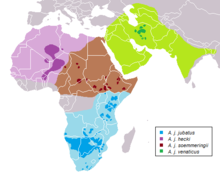East African cheetah
| Tanzanian cheetah | |
|---|---|
 |
|
| A Tanzanian cheetah in Masai Mara, Kenya. | |
| Scientific classification | |
| Kingdom: | Animalia |
| Phylum: | Chordata |
| Class: | Mammalia |
| Order: | Carnivora |
| Suborder: | Feliformia |
| Family: | Felidae |
| Genus: | Acinonyx |
| Species: | A. jubatus |
| Subspecies: | A. j. raineyi |
| Trinomial name | |
|
Acinonyx jubatus raineyi (Heller, 1913) |
|
 |
|
| A. j. raineyi range (red) | |
| Synonyms | |
|
Acinonyx jubatus fearsoni |
|
Acinonyx jubatus fearsoni
(Smith, 1834)
Acinonyx jubatus fearonis
(Fitzinger, 1869)
Acinonyx jubatus ngorongorensis
(Hilzheimer, 1913)
Acinonyx jubatus velox
(Heller, 1913)
The Tanzanian cheetah (Acinonyx jubatus raineyi syn. Acinonyx jubatus fearsoni), also commonly known as East African cheetah or Kenyan cheetah, is a subspecies of cheetah native to East Africa. They live in grasslands and savannas of Tanzania, Kenya, Uganda and Somalia. The Tanzanian cheetahs are inhabiting mainly the Serengeti ecosystem, the Maasai Mara and the Tsavo landscape. The East African specimen was described by the American zoologist Edmund Heller under the trinomen Felis jubatus raineyi in British East Africa in 1913.
These cheetahs are listed as Vulnerable by the IUCN, as it is threatened by habitat loss, predation and cheetah cub mortality rated up to 90% in the Serengeti ecosystem.
In 2007, the total number of cheetahs in East Africa were estimated at 1,960 to 2,572 adults and independent adolescents. Tanzanian cheetahs are the second-largest population after the most numerous South African cheetah. In 2007, there were between 569 and 1,007 cheetahs in Tanzania, between 710 and 793 cheetahs in Kenya, between 40 and 295 cheetahs in Uganda and approximately 200 left in Somalia. Kenya is the main stronghold for Eastern African cheetahs, with the largest population of 800 to 1,200 adults in the country since 2015. In 2016, it was estimated that more than 1,000 individuals live in the Serengeti/Maasai Mara ecosystem of Tanzania and Kenya.
...
Wikipedia

